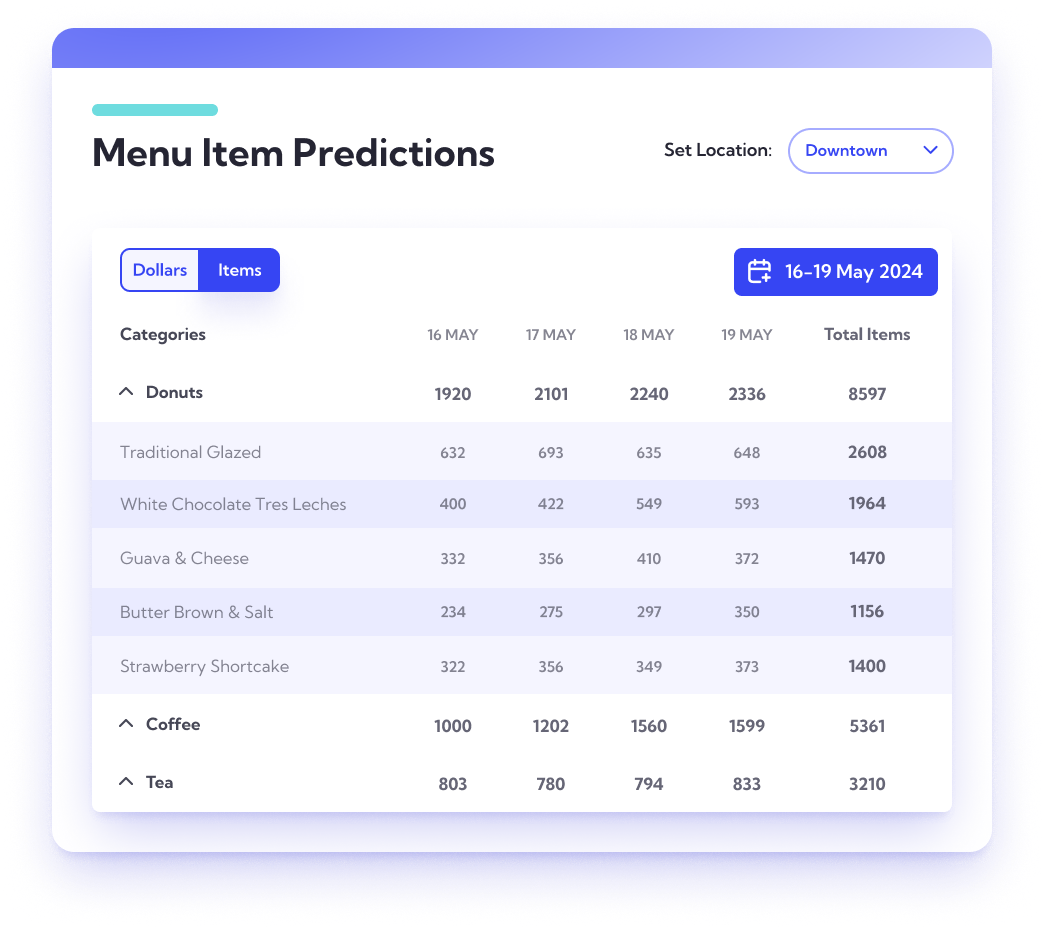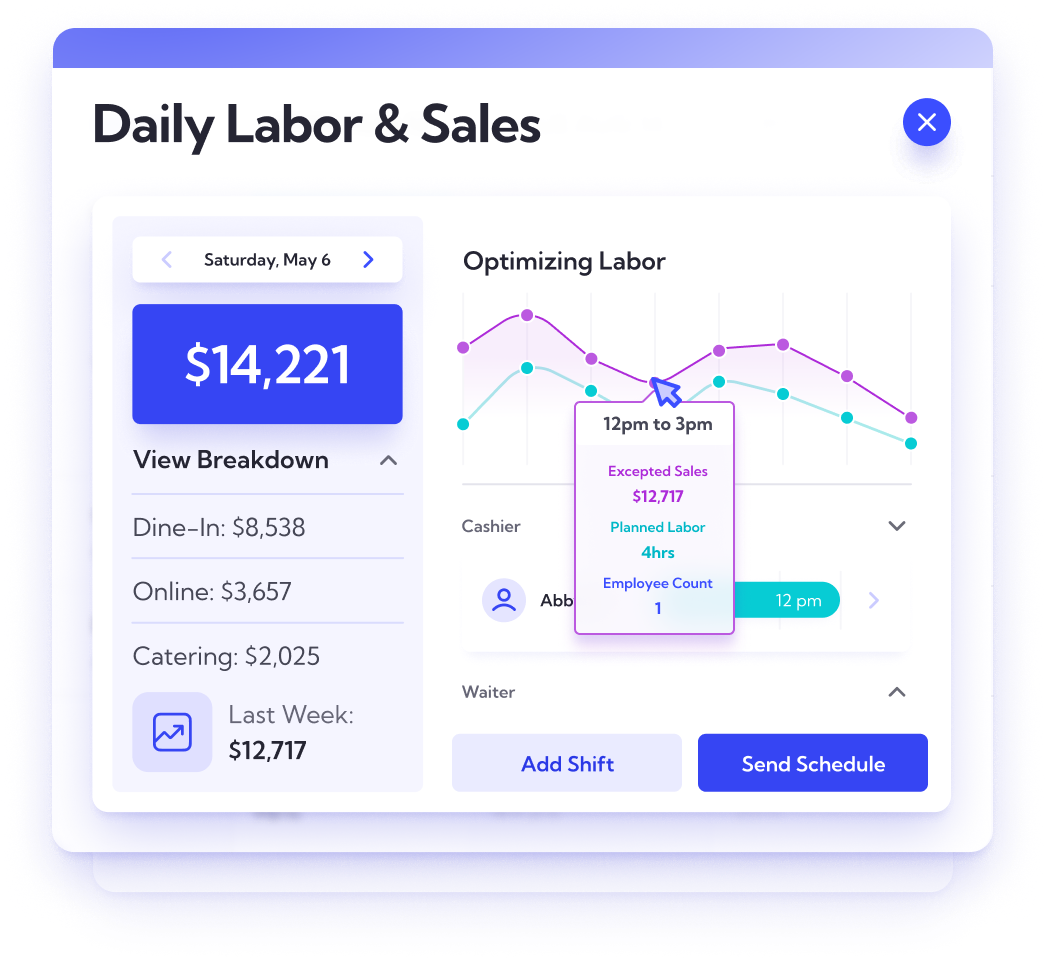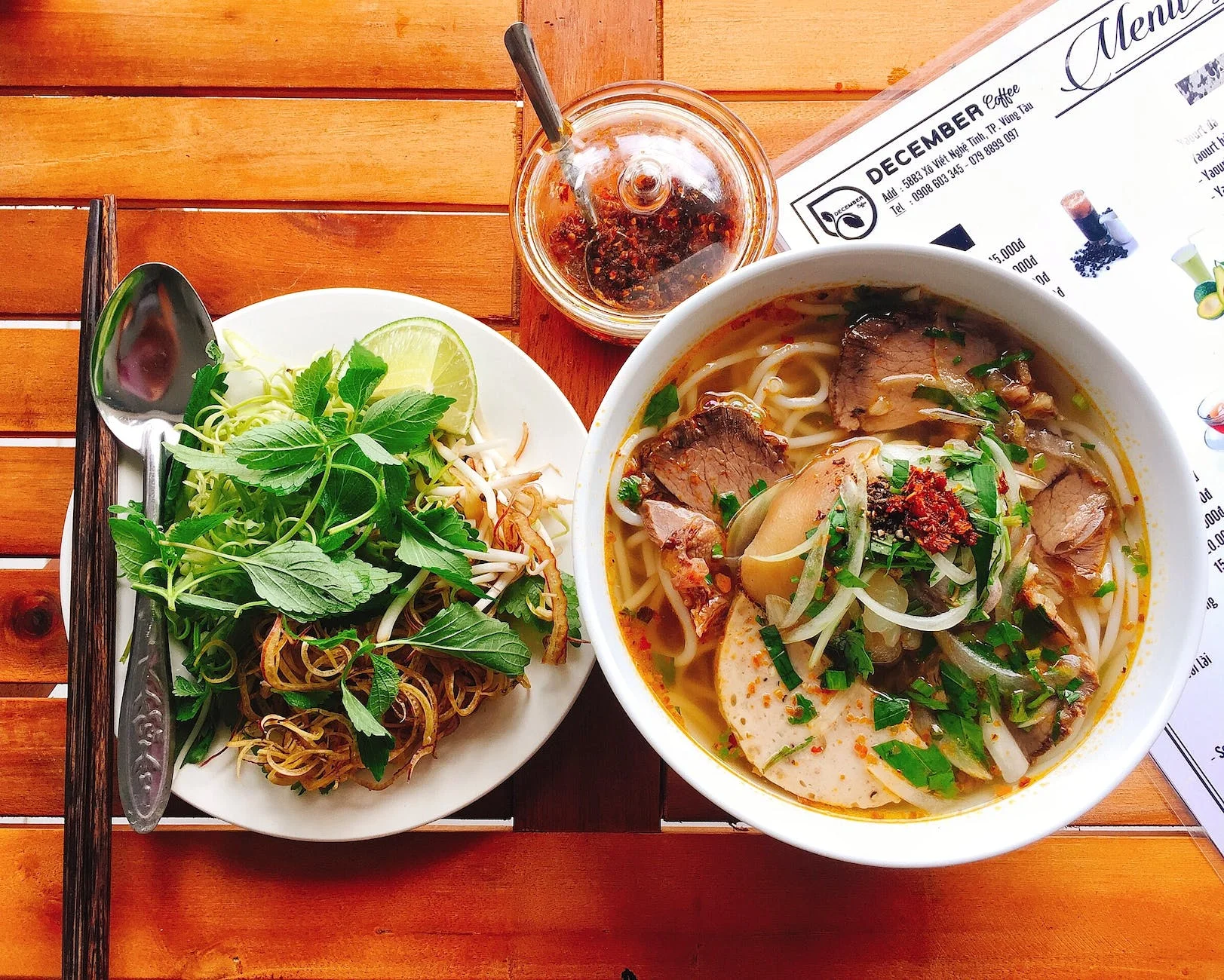In the restaurant industry, where the effective use of analytical tools and technology is increasingly becoming the norm, the ability to predict and plan for future demand transitions from a mere advantage to an essential strategic imperative.
Dive with us into the world of restaurant menu forecasting, a strategic tool that can significantly influence a restaurant's success.
What is Restaurant Menu Forecasting
Menu forecasting is the process of predicting what and how much customers will order over a given period in a restaurant. This involves analyzing historical sales data, current market trends, and other factors like weather, seasonality and local events. It encompasses all aspects of the menu, including various types of dishes, beverages, and specials. The primary purpose of menu forecasting is to align a restaurant's offerings with anticipated customer demand.
Restaurant Menu Forecasting vs Restaurant Menu Item Forecasting
While menu forecasting is a broader concept that involves predicting the overall demand for the restaurant's menu over a specific period, menu item forecasting, on the other hand, is more specific and focuses on predicting the demand for individual menu items. It involves a detailed analysis of each dish or beverage's popularity and sales trends. This method is used for a granular analysis of each menu item, helping to determine which items should be promoted, modified, or discontinued.
Key Differences
- Level of Detail: Menu forecasting looks at the menu as a whole, while menu item forecasting drills down into the specifics of each item.
- Application: Menu forecasting is more about overall strategy and operations, whereas menu item forecasting is about optimizing and adapting individual menu offerings.
- Outcome: The outcome of menu forecasting is a well-planned overall menu strategy, while menu item forecasting leads to a refined and targeted menu with a focus on individual items.
Check out Lineup.ai's AI-driven menu forecasting feature for precise restaurant demand prediction, inventory management, and waste reduction, ensuring optimal stock levels and cost control.

The Role of Forecasting in Menu Planning and Inventory Management
Forecasting plays a pivotal role in menu planning. It helps in identifying which dishes are likely to be in demand, allowing chefs and managers to design menus that cater to customer preferences while also being cost-effective. This process is vital for seasonal menu changes, special events, and introducing new items.
In inventory management, menu forecasting is indispensable. It informs purchasing decisions, ensuring that the right ingredients are in stock when needed. Effective menu forecasting reduces the risk of overstocking, which can lead to spoilage and increased costs, or understocking, which can result in lost sales and customer dissatisfaction. By predicting the popularity of menu items, restaurants can order ingredients in optimal quantities, striking a balance between availability and freshness.
In summary, understanding the basics of restaurant menu forecasting is essential for efficient restaurant operation. It not only aids in making informed decisions about menu design and inventory but also plays a significant role in cost management and enhancing the overall customer experience.
Key Benefits of Effective Menu Forecasting
Effective menu forecasting offers a multitude of benefits for restaurants, playing a crucial role in enhancing operational efficiency, profitability, and customer satisfaction. Here are some key benefits of implementing effective menu forecasting.

Cost Reduction and Waste Management
Effective forecasting directly contributes to cost reduction by minimizing over-purchasing and waste. By accurately predicting demand, restaurants can order more efficiently, reducing the amount of unsold food that goes to waste.
Enhanced Customer Satisfaction and Menu Diversity
Forecasting enables restaurants to maintain a diverse menu that aligns with customer preferences and seasonal availability. This diversity not only satisfies a broader range of customer tastes but also keeps the menu interesting and dynamic, encouraging repeat business.
Improved Operational Efficiency
Knowing the expected demand helps in efficient staff scheduling and kitchen preparation. Restaurants can allocate the right number of staff for preparation, cooking, and service, ensuring that operations run smoothly, especially during peak times.
Data-Driven Decision Making
Menu forecasting involves analyzing sales data, customer preferences, and market trends. This data-driven approach allows restaurant managers to make informed decisions about menu changes, pricing strategies, and promotional activities.
Advanced Techniques in Restaurant Menu Forecasting
Exploring advanced techniques in restaurant menu forecasting reveals a range of methods that can significantly enhance a restaurant's efficiency and profitability. These methods include the popularity index, pre-costing, volume forecasting, and the application of technology. Below is an overview of these methods, a guide to implementing them, and real-world examples of successful menu forecasting.
1. Popularity Index
This method involves analyzing sales data to determine the most and least popular items on the menu. It helps in making informed decisions about which dishes to promote or discontinue.
Implementing the Popularity Index:
- Collect and analyze sales data for each menu item.
- Calculate the percentage of total orders for each item.
- Adjust the menu based on the popularity of items.
2. Pre-Costing
Pre-costing involves calculating the cost of each menu item before it is sold. This method is crucial for setting appropriate prices and ensuring each dish contributes to profitability.
Implementing Pre-Costing:
- Calculate the cost of ingredients for each dish.
- Factor in other costs like labor and overheads.
- Set menu prices that cover these costs and ensure profitability.
3. Volume Forecasting
This technique predicts the number of each menu item that will be sold. It is essential for efficient inventory management and reducing food waste.
Implementing Volume Forecasting:
- Analyze past sales data, considering seasonality and trends.
- Predict the quantity of each dish to be sold in a given period.
- Adjust inventory and preparation schedules accordingly.
4. Applying Technology
Modern restaurants are increasingly using technology for forecasting. Data analytics and AI forecasting software for restaurants can process vast amounts of data for more accurate predictions.
Implementing Technology-Driven Forecasting:
- Invest in a restaurant management system with forecasting capabilities.
- Integrate it with your POS system to analyze sales trends.
- Use the system’s analytics for data-driven menu decisions.
Tools like Lineup.ai offer AI-powered solutions for sales and menu item forecasting. Lineup.ai simplifies complex demand challenges for restaurants and offers a range of features that can set your restaurant up for success:
- Automated and Standardized Processes: It replaces manual estimating and demand planning, making predictions about restaurant demand, sales, and labor more accurate and efficient. The software uses historical and real-time transaction data from your POS, combines it with external factors like local events and weather and then analyzes this data to identify patterns and trends in customer behavior, menu item popularity, and sales volumes.
- Detailed Restaurant Sales Predictions: The software generates hourly, daily, and weekly sales forecasts with unprecedented accuracy, thanks to predictive analytics. Its unique algorithm continuously learns and identifies patterns for better future forecasts.
- Better Restaurant Labor Planning: Lineup.ai provides solid labor insights for optimal staffing at each location and shift, reducing under- and overstaffed scenarios.
- Built-in Restaurant Shift Scheduling: The software helps balance shift scheduling, avoiding employee burnout and optimizing shifts for better service delivery.

Challenges in Menu Forecasting
Menu forecasting is a critical component of restaurant management, but it's not without its challenges. Understanding these challenges and implementing effective solutions is key to successful forecasting.
Unpredictable Customer Behavior
Challenge: Customer preferences can be unpredictable, making it difficult to accurately forecast demand for menu items.
Solution: Utilize data analytics tools like Lineup.ai to track and analyze customer behavior over time. Implement feedback mechanisms, like comment cards or digital surveys, to gain insights into customer preferences.
Seasonal Variations and Trends
Challenge: Seasonal changes can significantly impact customer preferences, making some menu items more popular at certain times of the year.
Solution: Incorporate seasonal trends into forecasting models using Lineup.ai. Adjust the menu to include seasonal ingredients and dishes that align with current trends.
Inaccurate or Insufficient Data
Challenge: Lack of accurate sales data can lead to poor forecasting, resulting in overstocking or understocking of ingredients.
Solution: Invest in a robust POS system that accurately tracks sales data. Regularly review and clean data to ensure accuracy. Consider integrating your POS system with inventory management software for real-time data synchronization.
Complexity in Forecasting for Multiple Locations
Challenge: For restaurants with multiple locations, forecasting can become complex due to varying customer preferences and local market conditions.
Solution: Tailor forecasting models for each location, taking into account local trends and customer demographics. Utilize tools like Lineup.ai to aggregate and analyze data across all locations.
Getting Employee Buy-In for New Technologies
Challenge: Adapting to and integrating new forecasting technologies can be daunting, especially for establishments used to traditional methods.
Solution: Invest in training for staff to effectively use new technologies. Start with a pilot program to test and adjust the use of technology in forecasting before full-scale implementation.
Conclusion
For restaurateurs, the adoption of menu forecasting is not just a recommendation; it's a strategic imperative for sustained success. Embracing forecasting methods, especially those augmented by modern technologies like AI and data analytics, can lead to remarkable improvements in various facets of restaurant operations.
